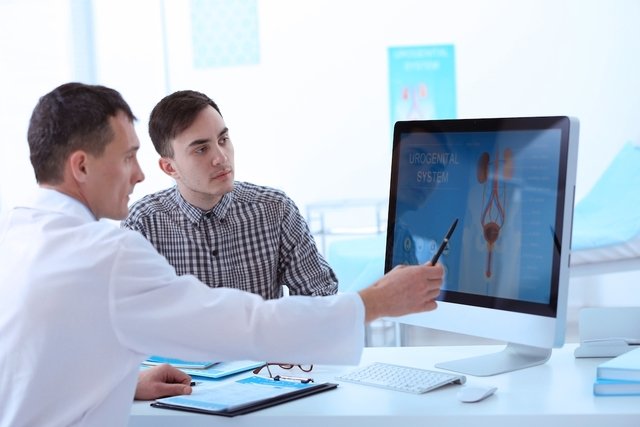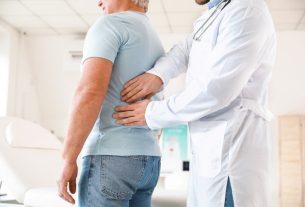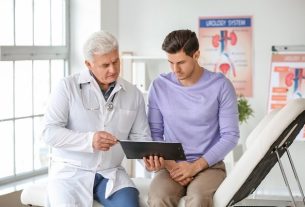Pain in the testicles is a symptom that can affect men of all ages and can be classified as acute or chronic. Acute pain is pain that appears quickly and lasts a few hours or days, and is generally caused by a blow to the testicles.
Chronic pain appears slowly and lasts for several weeks or months, and may be a sign of more serious problems such as inguinal hernia, varicocele or chronic inflammatory processes, for example.
In rarer cases, this type of pain can also indicate the presence of testicular cancer, although it is more common that with cancer a man does not feel pain, being able to identify only a nodule or hardened lump. Learn more about how to identify testicular cancer.

7 main causes of testicular pain
The most common causes of testicular pain include:
1. Varicocele
Varicocele is a dilation of the testicular veins that most often occurs in the left testicle, but can also affect just the right testicle or both. This change causes constant discomfort, swelling in the testicles and a feeling of heat, especially after walking or doing some physical activity. Understand more about varicocele.
How to deal with: in most cases, the pain caused by varicocele is treated with analgesic medications such as Paracetamol or Dipyrone. However, if there is a risk of infertility or if the pain does not improve with the use of medication, it may be necessary to perform a small surgery to “connect” the affected veins and ensure that the blood only circulates through the healthy vessels.
2. Inguinal hernia
Inguinal hernia is very common in children and young adults, occurring when a portion of the intestine, or other abdominal contents, manages to pass through a weakened area of the abdominal muscles, entering the scrotum and causing swelling and constant pain, which can worsen when standing up. bending over or lifting weights, for example.
How to deal with: the only form of treatment available is surgery for inguinal hernia, which allows the portion of the intestine to be replaced in the correct location and strengthen the abdominal muscles. Find out more about how the treatment is carried out.
3. Epididimite
Inflammation of the epididymis, also known as epididymitis, can be caused by bacteria or viruses, and its symptoms include intense pain, swelling of the testicle, redness and fever with chills.
How to deal with: it is necessary to consult a urologist to assess the need to start using antibiotics, which may be ceftriaxone or quinolones (usually ciprofloxacin), and the treatment period may vary.
4. Testicle torsion
Torsion of the testicle is normally an emergency situation that is most common before the age of 25 and causes very intense pain, however, there are cases in which this torsion does not happen completely and, therefore, the man may only experience discomfort. constant or intense pain that comes and goes with movements. See the other common symptoms of torsion.
How to deal with: in case of suspected torsion of the testicle, it is important to go quickly to the emergency room to confirm the diagnosis and undergo surgery to replace the testicle in the correct location, avoiding complications such as infertility.
5. Prostatitis
Inflammation of the prostate, known as prostatitis, typically causes symptoms such as painful urination, fever, perineal pain and a feeling of being unable to empty the bladder. However, it is also common to experience pain in the testicles, which worsens when palpating the region.
How to deal with: a good way to relieve pain is to take a sitz bath with warm water for 15 minutes and practice kegel exercises, however, it is almost always necessary to take antibiotics prescribed by the urologist, such as ciprofloxacin or levofloxacin.
6. Mumps
Although mumps normally affects the parotid glands, which are found on the side of the face, the virus that causes the disease can also travel to the testicles, causing inflammation. Therefore, pain in the testicles may occur after a case of mumps, due to the migration of the virus.
How to deal with: Anti-inflammatory and analgesic medications, such as Ibuprofen or Paracetamol, are normally used to alleviate symptoms. But it is also necessary to rest and drink plenty of water during the day to help the body eliminate the virus. Find out more about why mumps can travel to the testicles and what to do.
7. Testicular cancer
Testicular cancer rarely causes pain, however, in more advanced cases pain may occur. However, in these cases it is also common for other symptoms to appear beforehand that indicate that something is affecting the region, such as intense swelling, changes in the size of the testicles and lumps, for example. Check out what signs may indicate cancer.
How to deal with: whenever cancer is suspected, it is very important to consult a urologist as soon as possible, as early diagnosis improves the chances of a cure. However, in almost all cases it is necessary to remove the affected testicle.

Sign up for our newsletter and stay up to date with exclusive news
that can transform your routine!
Warning: Undefined array key "title" in /home/storelat/public_html/wp-content/plugins/link-whisper-premium/templates/frontend/related-posts.php on line 12
Warning: Undefined array key "title_tag" in /home/storelat/public_html/wp-content/plugins/link-whisper-premium/templates/frontend/related-posts.php on line 13



